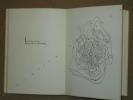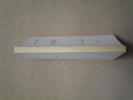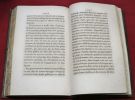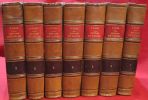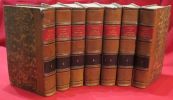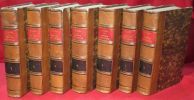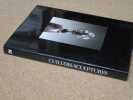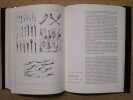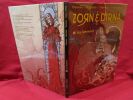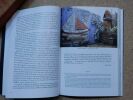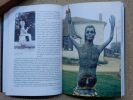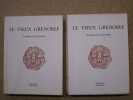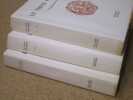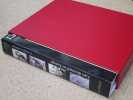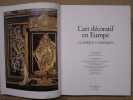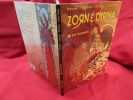6522 books for « bruno de j m »Edit
-
Type
Any type (1)
Artists book (1)
Autograph (1)
Book (6359)
Drawings (1)
Magazine (6)
Music sheets (144)
New book (5)
Old papers (1)
Photographs (3)
-
Latest
Last 24h (1)
Last 3 days (5)
Last month (72)
Last week (10)
-
Language
Dutch (4)
English (7)
French (6496)
German (9)
Italian (6)
-
Century
16th (2)
17th (1)
18th (9)
19th (56)
20th (2682)
21st (1421)
-
Countries
Belgium (316)
Canada (38)
Côte d'Ivoire (4)
Denmark (9)
France (5478)
Germany (2)
Greece (1)
Italy (48)
Switzerland (614)
United Kingdom (12)
-
Syndicate
ALAC (34)
CLAM (13)
CLAQ (8)
CNE (1)
ILAB (2697)
NVVA (83)
SLACES (83)
SLAM (2477)
SNCAO (5)
Topics
- 1900 (21)
- Alsace (23)
- Archaeology (34)
- Architecture (93)
- Autographs (38)
- Barber (26)
- Belgium (27)
- Biography (53)
- Brazil (33)
- Brehm bruno (18)
- Bruno g. (47)
- Children’s books (111)
- Christianity (36)
- Christmas (17)
- Cinema (37)
- Comic strip (115)
- Cooking (58)
- Culinary art (23)
- Dedication (42)
- Detective novels (40)
- Drawings (28)
- Economics (64)
- Education (101)
- Education - morals (64)
- English (47)
- Fashion (21)
- Fine arts (74)
- First edition (52)
- Fischer bruno (32)
- Fox (29)
- Gallimard (26)
- Gastronomy (17)
- Gay lussac (71)
- Geography (36)
- Germanic languages (52)
- Gibert (34)
- Greece (17)
- Guide books (38)
- Helvética (47)
- History (245)
- Humour anecdotes (25)
- Industrial arts & crafts - fine arts (24)
- Iron (24)
- Islam muslim (17)
- Italian (26)
- Italy (45)
- Journalism (34)
- Law (29)
- Linnean society of lyons (42)
- Literature (365)
- Lyons and area (42)
- Lyons college (42)
- Lyons college pc (42)
- Lyons revue (42)
- Magazine (64)
- Masure bruno (54)
- Medicine (58)
- Museums (17)
- Music (27)
- Navy (20)
- Newspapers press (105)
- Painting (44)
- Paris (39)
- Philosophy (107)
- Photography (113)
- Poetry (65)
- Policy (91)
- Professions guilds (25)
- Provence (23)
- Psychiatry neurology (34)
- Psychoanalysis (48)
- Psychology (117)
- Racine jean (20)
- Reading vocabulary (41)
- Regionalism (56)
- Religions (99)
- Review (51)
- Reviews (79)
- Sciences (50)
- Scores (164)
- Sculpture (33)
- Social sciences (20)
- Sociology (42)
- Songs (131)
- Sports (21)
- Switzerland (41)
- Theatre (27)
- Theology (46)
- Translation (18)
- Travel (22)
- Valcke bruno (16)
- Various (53)
- Vintage (18)
- Viticulture (17)
- War (56)
- Weil simone (28)
- Wine (21)
- Youth (25)
Ecriture, dessins.
Fontaine 1947 Fontaine, Paris, 1947, exemplaire numéroté 10/221, broché, environ 20x14cm, couverture insolée, bon état pour le reste.
Bruno Capacci a été membre des "Italiens de Paris" avec Chirico, Severini, Fini,... Il a été proche des surréalistes et mari de Suzanne Van Damme. Merci de nous contacter à l'avance si vous souhaitez consulter une référence au sein de notre librairie.
[HAUTERIVE, Pierre-Louis-Auguste-Bruno Blanc de La Nautte, Comte d'.]
Reference : 102384
Elemens (Eléments) d'Economie Politique, suivis de Quelques Vues sur l'Application des Principes de cette Science aux Règles administratives.
A Paris, chez Fantin, Libraire, 1817, 1 volume in-8 de 205x128 mm environ, 4 ff. (faux-titre, titre, table), xxj-384 pages, pleine basane racinée brune, dos lisse portant titres dorés sur pièce de titre rouge, orné de motifs dorés, plats encadrés d'une guirlande dorée, coupes dorées, gardes et tranches. jaspées. Coins mors et coiffes frottés, dos décoloré, légères rousseurs, sinon bon état. Première Edition.
Pierre-Louis-Auguste-Bruno Blanc de La Nautte, comte d'Hauterive (7 mars 1797, Gap - 14 décembre 1870, Pau), est un homme politique français. Conseiller d'Etat de Napoléon. Merci de nous contacter à l'avance si vous souhaitez consulter une référence au sein de notre librairie.
Histoire de la République de Venise Par P. DARU (7 volumes).
A Paris, chez Firmin Didot, Imprimeur du Roi, 1819, complet en 7 volumes in-8 de 210x130 mm environ, 640, 560, 710, 678, 684, vij-720, 671 pages, demi reliure veau bistre, dos à nerfs portant titres et tomaisons dorés, sur pièces de titre rouge et tomaisons noires, gardes marbrées. Avec 8 planches dépliantes. Quelques erreurs de pagination, coiffes supérieures ébréchées avec début de fentes sur la plupart des volumes, galeries sur certains mors-peaux (tome 3), épidermures, petites rousseurs et pages brunies, déchirure restaurée sur une coiffe (tome 1), sinon bon état. Edition originale.
Pierre-Antoine-Noël-Mathieu Bruno Daru, né à Montpellier le 12 janvier 1767 et mort à Meulan au château de Bècheville le 5 septembre 1829, est un homme d'État et homme de lettres français. Comte d'Empire, il est l'homme dont Napoléon Ier à Sainte-Hélène résumait l'éloge en ces termes : « Il joint le travail du buf au courage du lion". Merci de nous contacter à l'avance si vous souhaitez consulter une référence au sein de notre librairie.
Bruno Bettelheim présente : les mille et une nuits, choix de contes.
Seghers, Coll. Bruno Bettelheim présente, 1978, 210 p., broché, bon état.
Traduction de l'introduction et choix des contes par Théo Carlier. Merci de nous contacter à l'avance si vous souhaitez consulter une référence au sein de notre librairie.
BUHOT-LAUNAY Xavier / SZIUBINSKY Michaël / LAMANDA Jean-René / LASBORDES Michel / PHILIPPE Jean-Pierre / THOBIE Bruno / VERGOZ Philippe / VIVIER François
Reference : 114893
(1995)
Restaurer, entretenir les bateaux en bois.
Chasse-Marée Armen 1995 Editions Le Chasse-Marée / Armen, 1995, 345 p., cartonnage toilé éditeur, environ 28x22cm. Dos un peu applati vers le premier plat, un signature sur la page de faux-titre, pas de jaquette. Bon état pour le reste.
La rédaction du Chasse-Marée, avec la collaboration de BUHOT-LAUNAY Xavier, SZIUBINSKY Michaël, LAMANDA Jean-René, LASBORDES Michel, PHILIPPE Jean-Pierre, THOBIE Bruno, VERGOZ Philippe, VIVIER François et les Ateliers de l'Enfer. Merci de nous contacter à l'avance si vous souhaitez consulter une référence au sein de notre librairie.
Zorn & Dirna, tome 1, les Laminoirs. (dédicacé).
Soleil, DL mai 2001, première édition. Un album cartonné d'environ 32 x 23 cm, 48 pages, un coin très légèrement dénudé, sinon très bon état. Très belle dédicace de Bruno Bessadi en page de titre.
Merci de nous contacter à l'avance si vous souhaitez consulter une référence au sein de notre librairie.
Les enfants sur les routes : Romain Kalbris, Sans Famille par Hector Malot / Le tour de la France par deux enfants par G. Bruno / P'tit bonhomme par Jules Verne.
Robert Laffont Bouquins Robert Laffont, Coll. Bouquins, 1994, 1153 p., broché, tranche salie, coins des plats cornés, bon état pour le reste, intérieur propre.
Merci de nous contacter à l'avance si vous souhaitez consulter une référence au sein de notre librairie.
Le livre idolâtre.
Calligrammes, 1983, broché, bords de la couverture frottés, intérieur propre.
Merci de nous contacter à l'avance si vous souhaitez consulter une référence au sein de notre librairie.
Ueber die Lehre des Spinoza in Briefen an den Herrn Moses Mendelssohn. Neue vermehrte Auflage. - [THE FIRST EVER TRANSLATION OF BRUNO'S ""DE UNO ET CAUSA""...]
Breslau, Gottl. Löwe, 1789, 8vo. Very beautiful contemporary red full calf binding with five raised bands and gilt green leather title-label to richly gilt spine. elaborate gilt borders to boards, inside which a ""frame"" made up of gilt dots, with giltcorner-ornamentations. Edges of boards gilt and inner gilt dentelles. All edges gilt. Minor light brownspotting. Marginal staining to the last leaves. Engraved frontispiece-portrait of Spinoza, engraved title-vignette (double-portrait, of Lessing and Mendelssohn), engraved end-vignette (portrait of Jacobi). Frontispiece, title-page, LI, (1, -errata), 440 pp. Magnificent copy.
First edition thus, being the seminal second edition, the ""neue vermehrte Auflage"" (new and expanded edition), which has the hugely important 180 pp. of ""Beylage"" for the first time, which include the first translation into any language of any part of Giordano Bruno's ""de Uno et Causa..."" (pp. 261-306) as well as several other pieces of great importance to the ""Pantheismusstreit"" and to the interpretation of the philosophy of Spinoza and Leibniz, here for the first time in print. The present translation of Bruno seems to be the earliest translation of any of Bruno's works into German, and one of the earliest translations of Bruno at all - as far as we can establish, the second, only preceded by an 18th century translation into English of ""Spaccio della bestia trionfante"". It is with the present edition of Jacobi's work that the interest in Bruno is founded and with which Bruno is properly introduced to the modern world. Jacobi not only provides what is supposedly the second earliest translation of any of Bruno's works ever to appear, he also establishes the great influence that Bruno had on two of our greatest thinkers, Spinoza and Leibnitz. It is now generally accepted that Spinoza founds his ethical thought upon Bruno and that Lebnitz has taken his concept of the ""Monads"" from him. It is Jacobi who, with the second edition of his ""Letters on Spinoza..."", for the first time ever puts Bruno where he belongs and establishes his position as one of the key figures of modern philosophy and thought. Bruno's works, the first editions of which are all of the utmost scarcity, were not reprinted in their time, and new editions of them did not begin appearing until the 19th century. For three centuries his works had been hidden away in libraries, where only few people had access to them. Thus, as important as his teachings were, thinkers of the ages to come were largely reliant on more or less reliable renderings and reproductions of his thoughts. As Jacobi states in the preface to the second edition of his ""Letters on Spinoza..."", ""There appears in this new edition, under the title of Appendices (""Beylage""), different essays, of which I will here first give an account. The first Appendix is an excerpt from the extremely rare book ""De la causa, principio, et Uno"", by Jordan Bruno. This strange man was born, one knows not in which year, in Nola, in the Kingdom of Naples"" and died on February 17th 1600 in Rome on the stake. With great diligence Brucker has been gathering information on him, but in spite of that has only been able to deliver fragments [not in translation]. For a long time his works were, partly neglected due to their obscurity, partly not respected due to the prejudice against the new opinions and thoughts expressed in them, and partly loathed and suppressed due to the dangerous teachings they could contain. On these grounds, the current scarcity of his works is easily understood. Brucker could only get to see the work ""De Minimo"", La Croce only had the book ""De Immenso et Innumerabilibus"" in front of him, or at least he only provides excerpts from this [also not in translation], as Heumann does only from the ""Physical Theorems"" [also small fragments, not in translation]"" also Bayle had, of Bruno's metaphysical works, himself also merely read this work, of which I here provide an excerpt."" (Vorrede, pp. (VII)-VIII - own translation from the German). Jacobi continues by stating that although everyone complains about the obscurity of Bruno's teachings and thoughts, some of the greatest thinkers, such as Gassendi, Descartes, ""and our own Leibnitz"" (p. IX) have taken important parts of their theorems and teachings from him. ""I will not discuss this further, and will merely state as to the great obscurity (""grossen Dunkelheit"") of which people accuse Bruno, that I have found this in neither his book ""de la Causa"" nor in ""De l'Infinito Universo et Mondi"", of which I will speak implicitly on another occasion. As to the first book, my readers will be able to judge for themselves from the sample (""Probe"") that I here present. My excerpt can have become a bit more comprehensible due to the fact that I have only presented the System of Bruno himself, the ""Philosophia Nolana"" which he himself calls it, in its continuity... My main purpose with this excerpt is, by uniting Bruno with Spinoza, at the same time to show and explain the ""Summa of Philosophy"" (""Summa der Philosophie"") of ""En kai Pan"" [in Greek characters - meaning ""One and All""]. ... It is very difficult to outline ""Pantheism"" in its broader sense more purely and more beautifully than Bruno has done."" (Vorrede pp. IX-XI - own translation from the German). So not only does Jacobi here provide this groundbreaking piece of Bruno's philosophy in the first translation ever, and not only does he provide one of the most important interpretations of Spinoza's philosophy and establishes the importance of Bruno to much of modern thought, he also presents Bruno as the primary exponent of ""pantheism"", thereby using Bruno to change the trajectory of modern thought and influencing all philosophy of the decades to come. After the second edition of Jacobi's ""Ueber die Lehre des Spinoza"", no self-respecting thinker could neglect the teachings of Bruno"" he could no longer be written off as having ""obscure"" and insignificant teachings, and one could no longer read Spinoza nor Leibnitz without thinking of Bruno. It is with this edition that the world rediscovers Bruno, never to forget him again.WITH THE FIRST EDITION OF ""UEBER DIE LEHRE DES SPINOZA"" (1785), JACOBI BEGINS THE FAMOUS ""PATHEISMUSSTREIT"", which focused attention on the apparent conflict between human freedom and any systematic, philosophical interpretation of reality. In 1780, Jacobi (1743-1819), famous for coining the term nihilism, advocating ""belief"" and ""revelation"" instead of speculative reason, thereby anticipating much of present-day literature, and for his critique of the Sturm-und-Drang-era, had a conversation with Lessing, in which Lessing stated that the only true philosophy was Spinozism. This led Jacobi to a protracted and serious study of Spinoza's works. After Lessing's death, in 1783 Jacobi began a lengthy letter-correspondende with Mendelssohn, a close friend of Lessing, on the philosophy of Spinoza. These letters, with commentaries by Jacobi, are what constitute the first edition of ""Ueber die lehre des Spinoza"", as well as the first part of the second edition. The second edition is of much greater importance, however, due to greatly influential Appendices. The work caused great furor and the enmity of the Enlightenment thinkers. Jacobi was ridiculed by his contemporaries for attempting to reintroduce into philosophy belief instead of reason, was seen as an enemy of reason and Enlightenment, as a pietist, and as a Jesuit. But the publication of the work not only caused great furor in wider philosophical circles, there was also a personal side to the scandal which has made it one of the most debated books of the period: ""Mendelssohn enjoyed, as noted at the outset, a lifelong friendship with G. E. Lessing... Along with Mendelssohn, Lessing embraced the idea of a purely rational religion and would endorse Mendelssohn's declaration: ""My religion recognizes no obligation to resolve doubt other than through rational means"" and it commands no mere faith in eternal truths"" (Gesammelte Schriften, Volume 3/2, p. 205). To pietists of the day, such declarations were scandalous subterfuges of an Enlightenment project of assimilating religion to natural reason... While Mendelssohn skillfully avoided that confrontation, he found himself reluctantly unable to remain silent when, after Lessing's death, F. H. Jacobi contended that Lessing embraced Spinoza's pantheism and thus exemplified the Enlightenment's supposedly inevitable descent into irreligion.Following private correspondence with Jacobi on the issue and an extended period when Jacobi (in personal straits at the time) did not respond to his objections, Mendelssohn attempted to set the record straight about Lessing's Spinozism in ""Morning Hours"". Learning of Mendelssohn's plans incensed Jacobi who expected to be consulted first and who accordingly responded by publishing, without Mendelssohn's consent, their correspondence - ""On the Teaching of Spinoza in Letters to Mr. Moses Mendelssohn"" - a month before the publication of ""Morning Hours"". Distressed on personal as well as intellectual levels by the controversy over his departed friend's pantheism, Mendelssohn countered with a hastily composed piece, ""To the Friends of Lessing: an Appendix to Mr. Jacobi's Correspondence on the Teaching of Spinoza"". According to legend, so anxious was Mendelssohn to get the manuscript to the publisher that, forgetting his overcoat on a bitterly cold New Year's eve, he delivered the manuscript on foot to the publisher. That night he came down with a cold from which he died four days later, prompting his friends to charge Jacobi with responsibility for Mendelssohn's death.The sensationalist character of the controversy should not obscure the substance and importance of Mendelssohn's debate with Jacobi. Jacobi had contended that Spinozism is the only consistent position for a metaphysics based upon reason alone and that the only solution to this metaphysics so detrimental to religion and morality is a leap of faith, that salto mortale that poor Lessing famously refused to make. Mendelssohn counters Jacobi's first contention by attempting to demonstrate the metaphysical inconsistency of Spinozism. He takes aim at Jacobi's second contention by demonstrating how the ""purified Spinozism"" or ""refined pantheism"" embraced by Lessing is, in the end, only nominally different from theism and thus a threat neither to religion nor to morality."" (SEP).The Beylagen, which are not included in the 1785 first edition and only appear with the 1789 second edition, include: I. Auszug aus Jordan Bruno von Nola. Von der Ursache, dem Princip und dem Einen (p. 261-306) II. Diokles an Diotime über den Atheismus (p. 307-327) translation of Lettre ... sur l'Athéisme by F. Hemsterhuis.
Opera ea quae ad adinventam ab ipso ertem universalem, Scientiarum Artiumque omnium breui compendio, firmaque memoria apprehendendarum, locupletissimaque vel oratione ex tempore pertractandarum, pertinent. Ut et In eandem quorumdam interpretum scripti... - [SPARKING LEIBNIZ' DREAM OF A UNIVERSAL ALGEBRA]
Argentinae (i.e Strassburg], Lazarus Zetzner, 1598. 8vo. Very nice 19th century half calf with richly gilt spine. Some browning and spotting, but overall a nice copy. Many woodcut diagrams in the text. Woodcut printer's device to title-page. (24), 992, (32) pp.
Scarce first edition of this seminal publication, which is practically solely responsible for the spreading of both Lullism and Bruno's mnemonic theories in the 17th century. This publication constitutes the standard work on Lull for more than a century and it directly influenced the most significant thinkers of the following century, e.g. Leibnitz, whose dream of a universal algebra was stimulated by the reading of Lull (and Bruno) in the present publication.""In 1598, while the philosopher from Nola (i.e. Bruno) was in prison in Rome, Johann Heinrich Alsted together with the printer Lazarus Zetzner in Strasburg, published a great collection of the works by Raymond Lull and the most significant commentaries on Lullism, among them also some treatises by Bruno. Since then, Bruno's mnemonics was a basic component of all attempts made in the seventeenth century to set up a universal science on the basis of a theory of combinations interpreted in terms of Neo-Platonism... It was also Leibniz who was one of the first to assume similarities between Bruno's theory of the infinite and the Cartesian theory of vortices in an undetermined and infinite universe"" Leibniz had had the opportunity to read these treatises in his capacity as librarian of the Herzog August Library in Wolfenbüttel"". (Blum, p. 110). ""From another of Pierce's Lists we know that he possessed an important collection of Lullian and Lullist texts, namely the Renaissance edition by the famous Strasbourg editor Lazarus Zetzner: ""Raymundi Lulli Opera ea quae ad adinventam ab ipso Artem universalem... pertinent"" (printed first in 1598, then 1609, 1617 and, by his heirs, in 1651). This edition, which was very influential - the young Leibniz, for instance, acquainted himself with Llull through this anthology-, contains several works by Llull himself as well as those Renaissance commentaries on his works by Agrippa of Netteshein, Giordano Bruno..."" (Fidora, p. 181).This highly influential publication of Lull's ""Opera"" through which Leibniz and many of his contemporaries got acquainted with Lull and Bruno, contains seven genuine works by Lull (including the two most important works of the last period of the Art, the ""Ars brevis"" and the ""Ars magna""), four works falsely attributed to Lull, Agrippa's ""In Artem Brevem"" - and Bruno's four highly important commentaries on Lull, being the ""De Lulliano specierum scrutinio"" (pp. 685-97), ""De Lampade combinatoria Lulliana"" (pp. 698-755), ""De Progressu Logicae venationis"" (pp. 756-62) and ""De Lampade venatoria logicurum"" (pp. 763-806), which constitute Bruno's most important logical treatises and his seminal writings on mnemonics. The four treatises originally appeared separately in 1587 and 1588 respectively, and all appear here for the second time (apart from the ""De progressu"", which also appeared together with the first printing of the ""De Lampade venatoria logicorum"" the following year and here thus appears for the third time). The first printings of these works are of impossible scarcity and hardly obtainable. These four groundbreaking works appear together for the first time in the present publication and it is through this second printing of them that 17th century thinkers such as Leibniz got acquainted with them. Raymond Lull (ca. 1232-1315) was one of the most important and influential philosophers and logicians of his time. He is considered a pioneer of several fields of science, now most notably computation theory. His works sparked Leibniz' interest in the field and drove him to his seminal invention. Lull invented an ""art of finding truth"" (often in Lullism referred to as ""The Art""), which centuries later, when read in the present publication, stimulated Leibnitz' dream of a universal algebra. Lull applied this art to basically all subjects studied at the Medieval Universities. ""Lull's metaphysics worked a revolution in the history of philosophy"" (The Cambridge History of Renaissance Philosophy, p. 548). Giordano Bruno (1548-1600) is one of the most significant thinkers of modern times. He prepared the way for the rise of modern philosophy and became a forerunner of modern philosophy and science. His logical commentaries and mnemonic treatises were of special importance to the emerging logic of the 17th century and it is his version of Lullism that comes to dominate this significant strand of thought for more than a century. Having been arrested in 1592 due to alleged heresy, Bruno was subjected to a 6 year long trial that finally condemned him to hanging in 1600, two years after the publication of the four works that came to secure his influence over the following century. ""Bruno burned for philosophy"" he was killed for moral, physical, and metaphysical views that terrified and angered authorities."" (Copenhaver & Schmitt, p. 315).""By far the greatest figure of this generation was Giordano Bruno (1548-1600), whose interest in Llull dates almost exclusively from his sojurns in France and Germany. His activities in this field, which he combined with his other aspects of Reniassance philosophy, are too complex to be treated in any detail here. Suffice it to say with Frances Yates that ""the three strands of the Hermetism, the mnemonics, the Lullism are all interwoven in Bruno's complex personality, mind and mission""...""Perhaps the most important event of Lulliasm of this period was not the appearance of any new figure or work but the publication of an anthology by Lazarus Zetzner of Strasburg, entitled ""Raymundi Lullii, opera ea quae ad adinventam ab ipso Artem universalem"", which, for the next century or so, was to become the standard work on Llull. It is therefore instructive in understanding seventeenth-century Lullism... The first edition of this anthology appeared in Strasburg in 1598. It was reprinted in 1609... reprinted in 1617 and again in 1651... This mixture of Llull, pseudo-Llull, and Renaissance commentaries, emphasizing a general art of discourse, constituted the ""package"" in which Llull was presented to seventeenth-century readers, including Leibniz (note 33: it was apparently the first edition of 1598 that Leibniz read), and it must be kept in mind when discussing their version of Llull."" (Bonner, pp. 67-68). Bruno's works, the first editions of which are all of the utmost scarcity, were generally not reprinted in Bruno's lifetime and new editions of them did not begin appearing until the 19th century. For three centuries his works had been hidden away in libraries, where only few people had access to them. One very significant exception is the four treatises that we find in the present publication. They are among the only of Bruno's treatises to be published again before the 19th century, and as they don't appear again on their own, but here, in THE most important publication of Lull's writings for more than a century, it is through this second printing of these four works that Bruno comes to have his primary influence upon 17th century philosophy and science. His separate publications were simply not accessible to thinkers like Leibniz and could thus not be studied. Also therefore, Zetzners' 1598 publication of Lull and Bruno together proved to be of seminal importance, not only to the spreading of Lullism, but just as much to the spreading of Bruno's even more important theories. ""Raymond Lull (ab. 1232 - 1315), Majorcan writer, philosopher, memorycian (he was later to become a great source of inspiration for Giordano Bruno), logician, and a Franciscan tertiary. He wrote the first major work of Catalan literature. Recently-surfaced manuscripts show him to have anticipated by several centuries prominent work on elections theory. He is sometimes considered a pioneer of computation theory, especially given his influence on Gottfried Leibniz. He is also well known also as a glossator of Roman Law. Lull taught himself Arabic with the help from a slave. As a result, he wrote his ""Ars Magna"", which was intended to show the necessary reasons for the Christian faith. To promote his theory and test its effectiveness, he went to Algiers and Tunis. At the age of 82, in 1314, Lull traveled again to North Africa, where an angry crowd of Muslims stoned him in the city of Bougie. Genoese merchants took him back to Mallorca, where he died at home in Palma the following year."". (Thorndyke)Giordano Bruno was born in Nola in Southern Italy in 1548, and entered the Dominican order in Naples at the age of 18. While pursuing theological studies, he also thoroughly studied the ancient philosophers and began doubting some of the teachings of the Catholic Church. When he was in Rome in 1576, these doubts became known to the authorities of his order, and an indictment for heresy was prepared against him. Before he could be arrested, he escaped and began a long journey which took him to many European countries, among these England, where his most important works are published, until in 1592 he was denounced to the Inquisition and arrested. In 1593 he was taken to Rome, imprisoned, and subjected to a 6 year long trial. He firmly refused to recant his philosophical opinions, and in 1600 he was condemned for heresy, sentenced to death, and burned alive.SALVESTRINI NR. 1.See:Anthony Bonner: Doctor Illuminatus. A Ramon Llull Reader, 1993.Paul Richard Blum: Giordano Bruno. An Introduction, 2012.The Cambridge History of Renaissance Philosophy.Alexander Fidora: Peirce's Account of the Categories and Ramon Llull.
Le ciel réformé. Essai de traduction de partie du livre italien, Spaccio della Bestia Trionfante. - [INFLUENCING FRENCH ENLIGHTENMENT THOUGHT]
[Paris], 1750 [L'an 1000 700 50]. Small 8vo. Lovely contemporary full mottled calf with richly gilt spine and triple gilt line-borders to boards. All edges of boards gilt, and inner gilt dentelles. Some wear to extremities, especially capitals. Book plate removed from inside of front board. Half-title and title-page printed in red and black. Engraved title-vignette. A nice and clean copy, printed on good, heavy paper, and with wide margins. (4), 92 pp.
Scarce first translation into French of Giordano Bruno's seminal ""Expulsion of the Triumphant Beast"", being the first part of any of Bruno's works to be translated into French and presumably the second translation of any of Bruno's works into any language, only preceded by the equally scarce first translation into English of the same work (1713). ""The Expulsion of the Triumphant Beast"" constitutes one of Bruno's main works and that of his works which proved to be most influential throughout the 18th and 19th centuries, profoundly affecting both science, philosophy and religion, as it ""turns to social ethics and religious reform, but in a cosmic setting"". (Copenhaver & Schmitt, p. 301).Bruno's world-view as presented in the ""Spaccio"" cannot but have appealed directly to the French thinkers of the 18th century, when the first part of any of Bruno's works thus appears in French for the first time. The Enlightenment thinkers of 18th century France must have found much resonance with the extreme and provocative views held by the - until then - overlooked Renaissance thinker, who was burned on the stake due to his non-conformist views. ""Magic, pantheism, idolatory, demonolatory, apostasy - just these few outrages from the long list in the ""Spaccio"" would have been enough to anger the authorities, but there were more besides: Bruno doubted immortality, taught metempsychosis, recommended free-thinking, deserted positive for natural religion, criticized the Bible, defamed the Jews, slandered the Protestants, betrayed the Catholics, and condemned civil government besides."" (Copenhaver & Schmitt, p. 302). - Bruno's thoughts as expressed in the ""Spaccio"" doe not leave those of a Voltaire far behind.Bruno's works, the first editions of which are all of the utmost scarcity, were not reprinted in their time, and new editions of them did not begin appearing until the 19th century. For three centuries his works had been hidden away in libraries, where only few people had access to them. Thus, as important as his teachings were, thinkers of the ages to come were largely reliant on more or less reliable renderings and reproductions of his thoughts. The first translations of his works thus proved to be of seminal importance to the spreading of his ideas.As Jacobi states in the preface to the second edition of his ""Letters on Spinoza..."" (1785), ""This strange man was born, one knows not in which year, in Nola, in the Kingdom of Naples"" and died on February 17th 1600 in Rome on the stake. With great diligence Brucker has been gathering information on him, but in spite of that has only been able to deliver fragments [not in translation]. For a long time his works were, partly neglected due to their obscurity, partly not respected due to the prejudice against the new opinions and thoughts expressed in them, and partly loathed and suppressed due to the dangerous teachings they could contain. On these grounds, the current scarcity of his works is easily understood. Brucker could only get to see the work ""De Minimo"", La Croce only had the book ""De Immenso et Innumerabilibus"" in front of him, or at least he only provides excerpts from this [also not in translation], as Heumann does only from the ""Physical Theorems"" [also small fragments, not in translation]"" (pp. (VII)-VIII - own translation from the German). Bruno's most representative work, ""Spaccio de la bestia trionfante"" (The Expulsion of the Triumphant Beast), published in an atmosphere of secrecy in 1584 and never referred to as anything but blasphemous for more than a century, was singled out by the church tribunal at the summation of his final trial. That is hardly surprising because the book is a daring indictment of the corruption of the social and religious institutions of his day. The ""triumphant beast"" signifies the reign of multifarious vices. Cast in the form of allegorical dialogues, Bruno's work presents the deliberations of the Greek gods who have assembled to banish from the heavens the constellations that remind them of their evil deeds. The crisis facing Jove, the aging father of the gods, is symbolic of the crisis in a Renaissance world profoundly disturbed by new religious, philosophical, and scientific ideas."" (From Arthur D. Imerti's 1964 translation of the work into English).""Bruno, who had already used geometric diagrams and philosophical terms to present n infinite universe, now wrote a dialogue in which he transformed the cosmos by transforming its imagery. He called it ""The Triumphant Beast"", a phrase that brought to mind the book of Revelation [...] Unlike most of his contemporaries, who gave the universe about six thousand years of existence since creation, the Nolan philosopher had already proclaimed that it was infinitely old"" in ""The Expulsion of the Triumphant Beast"", he insists that the universe holds cultures and memories that have come and gone and will come and go again."" (Rowland, pp. 164-65).Giordano Bruno was born in Nola in Southern Italy in 1548, and entered the Dominical order in Naples at the age of 18. While pursuing theological studies, he also thoroughly studied the ancient philosophers and began doubting some of the teachings of the Catholic Church. When he was in Rome in 1576, these doubts became known to the authorities of his order, and an indictment for heresy was prepared against him. Before he could be arrested, he escaped and began a long journey which took him to many European countries, among these England, where his most important works are published, until in 1592 he was denounced to the Inquisition and arrested. In 1593 he was taken to Rome, imprisoned, and subjected to a 6 year long trial. He firmly refused to recant his philosophical opinions, and in 1600 he was condemned for heresy, sentenced to death, and burned alive. ""Bruno burned for philosophy"" he was killed for moral, physical, and metaphysical views that terrified and angered authorities."" (Copenhaver & Schmitt, p. 315).Salvestrini: 112Copenhaver & Schmitt: ""Renaissance Philosophy"", 1992.Ingrid D. Rowland: ""Girodano Bruno. Philosopher/Heretic"", 2008.See also: Cassirer: ""Das Erkenntnisproblem"", 1922 Bd. 1"" ""An Essay on Man"", 1944. Garin: ""Italian Humanism"", 1965. Paterson: ""The Infinite Worlds of Giordano Bruno"", 1970. Kristeller: ""Eight Philosophers of the Italian Renaissance"", 1964. Copenhaver & Schmitt: ""Renaissance Philosophy"", 1992. W. Boulting, ""Giordano Bruno"".
Eloge des jardins anarchiques. Accompagné du film de Rémy Ricordeau "Bricoleurs de Paradis".
L'Insomniaque 2011 L'Insomniaque, 2011, 219 p., broché, environ 24x17cm, avec le DVD du film, bon état.
Merci de nous contacter à l'avance si vous souhaitez consulter une référence au sein de notre librairie.
FONVIEILLE René / AVEZOU Robert / BASSETTE Louis / BOCQUET Aimé / BORDEAUX Léon / CHABERT Françoise / DARDELET Bruno et Etienne / DREYFUS Paul / FOIX DE MONTALAIS M.-H. / GIRARD Raymond / JALABERT Dominique / LACHAT Roger-Louis / LEFEVRE Roger / LEFRANCOIS Robert / DEL LITTO Victor / MERCIER Maurice / MOURRAL Pierre / ROCHE François / SIMIAND Paul / TROUSSIER Anthelme / THEVENON Pierre / D'UCKERMANN René / VAILLANT Pierre / VERMALE François.
Reference : 113038
(1968)
Le Vieux Grenoble : ses pierres et son âme, ses artistes, ses trésors d'art (3 volumes).
Roissard Grenoble 1968 Roissard, Grenoble, 1968-1970, 3 volumes brochés, environ 30x22cm, premier tome en édition originale numérotée 850/974, avec des envois des auteurs. Dos un peu aplatis vers le premier plat et légèrement insolés, une déchirure sans manque sur le haut et le bas des plats . Bon état pour le reste et intérieurs très propres.
Tomes 1 et 2 : Ses Pierres et son Ame / Tome 3 : ses artistes, ses trésors d'art. Merci de nous contacter à l'avance si vous souhaitez consulter une référence au sein de notre librairie.
GRUBER Alain (sous la direction de) / PONS Bruno / TER MOLEN Johan R; / REINHARDT Ursula / FOHR Robert
Reference : 112925
(1992)
L'art décoratif en Europe : Classique et Baroque.
Citadelles Mazenod 1992 Citadelles & Mazenod, 1992, 493 p., cartonnage éditeur sous jaquette et étui rouge, environ 32x25cm. Bords de la jaquette très légèrement frottés par endroits, des taches sur l'étui, bon état néanmoins et intérieur impeccable.
Merci de nous contacter à l'avance si vous souhaitez consulter une référence au sein de notre librairie.
QUAND LYON RUGIT... Les colères de Lyon du Moyen âge à nos jours.
Editions Lyonnaises d'Art et d'Hitoire 1998 Editions Lyonnaises d'Art et d'Histoire, 1998, 159 p., broché, bon état.
Merci de nous contacter à l'avance si vous souhaitez consulter une référence au sein de notre librairie.
Le livre des déserts : itinéraires scientifiques, littéraires et spirituels.
Robert Laffont, Bouquins Robert Laffont, Bouquins, 2005, 1231 p., broché, bon état.
Merci de nous contacter à l'avance si vous souhaitez consulter une référence au sein de notre librairie.
Zorn & Dirna, Les Laminoirs, tome 1.
Soleil, DL mai 2001, album cartonné d'environ 32x23 cm, 48 pages. En très bon état. Première édition.
Merci de nous contacter à l'avance si vous souhaitez consulter une référence au sein de notre librairie.
Le poids d'une vie, essais-souvenirs : La Vienne de Freud, Les enfants, L'héritage de l'holocauste.
Robert Laffont Robert Laffont, Coll. Réponses, 1991, 334 p., broché, un reste d'étiquette sur le second plat et quelques annotations au crayon à papier, légères traces d'adhésif sur les gardes, bon état pour le reste.
Table des matières abrégée : Freud et la psychanalyse / Les enfants et moi / Les Juifs et les camps de la mort. Merci de nous contacter à l'avance si vous souhaitez consulter une référence au sein de notre librairie.
Victimes de l'Occupation à Lyon et alentour : 81 monuments, 11 parcours.
Editions BGA Permezel, 2001, 139 p., broché, bon état.
Merci de nous contacter à l'avance si vous souhaitez consulter une référence au sein de notre librairie.
La forteresse vide.
Gallimard, 1989, 585 p., broché, bords de la couverture et mors frottés, des plis de lecture sur le dos, 2 pages cornées, une date et une signature sur le haut de la page de faux-titre.
Merci de nous contacter à l'avance si vous souhaitez consulter une référence au sein de notre librairie.
MESLIN Michel (sous la direction de ) / BERIOU Nicole / BOYER Régis / CLAVERIE Elisabeth / HUMBERT Elie-Georges / LAMBERT Pierre-Yves / LECOUTEUX Claude / MENARD Philippe / RENARD Jean-Bruno
Reference : 98314
Le merveilleux : l'imaginaire et les croyances en Occident.
Bordas Bordas, 1984, 231 p., cartonnage éditeur sous jaquette, environ 34x26cm, bords de la jaquette frottés par endroits, bon état pour le reste.
Merci de nous contacter à l'avance si vous souhaitez consulter une référence au sein de notre librairie.
BENOIT Bruno / CURTET Raymond / GIRL René / MOISSONNIER Maurice / MURE André / PREVOSTO Jacques / SAUSSAC Roland
Reference : 97900
24 maires de Lyon pour 2 siècles d'histoire.
Editions Lugd, Coll. Temps Présent, 1994, 245 p., un petit accroc d'1 cm environ en bordure du second plat, bon état pour le reste.
Merci de nous contacter à l'avance si vous souhaitez consulter une référence au sein de notre librairie.
Dalogues avec les mères, la première tâche : éduquer les parents.
Robert Laffont, Coll. Réponses, 1979, 306 p., broché, bon état.
Merci de nous contacter à l'avance si vous souhaitez consulter une référence au sein de notre librairie.
Dieu au XXIe siècle : contribution de la théologie aux temps qui viennent.
Bayard, 2002, 360 p., broché, coins des plats légèrement cornés, bon état.
Merci de nous contacter à l'avance si vous souhaitez consulter une référence au sein de notre librairie.
Pour être des partents acceptables : une psychanalyse du jeu.
Robert Laffont, Coll. Réponses, 1988, 400 p., broché, coins des plats cornés, bon état pour le reste.
Merci de nous contacter à l'avance si vous souhaitez consulter une référence au sein de notre librairie.
 Write to the booksellers
Write to the booksellers